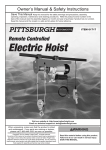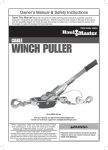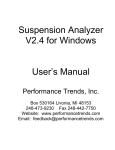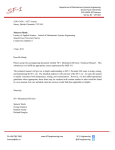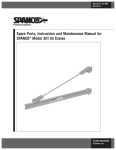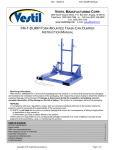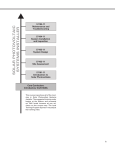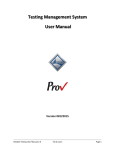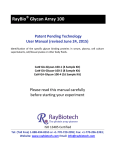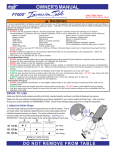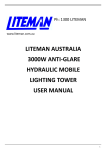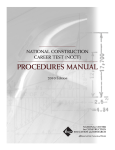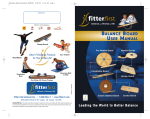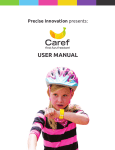Download Competencies, equipment and performance tasks Find out the
Transcript
Intermediate Rigging Module 38201-11 Annotated Instructor’s Guide Module Overview This module provides an overview of personnel lifting and lift planning, and introduces crane load charts and load balancing. It explains how the center of gravity is calculated and affects the lift. It also covers sling selection, and explains the uses of jacks, tuggers, hoists, skids, and rollers. Prerequisites Prior to training with this module, it is recommended that the trainee shall have successfully completed Basic Rigger. Objectives Upon completion of this module, the trainee will be able to do the following: 1. 2. 3. 4. 5. 6. 7. Describe the basic requirements to lift personnel. Explain how a sling stress is determined. Describe the basic elements of a lift plan. Explain the purpose of a load chart. Calculate and explain how the center of gravity is determined. Given a particular load, select the appropriate sling(s) for a lift. Describe how jacks, hoists, skids, and rollers are used to move load laterally. Performance Tasks Under the supervision of the instructor, the trainee should be able to do the following: 1. Calculate the center of gravity of a load. 2. Given a particular load, select the appropriate sling(s) for a lift. Materials and Equipment Multimedia projector and screen Basic Rigger / Intermediate Rigger / Advanced Rigger PowerPoint® Presentation Slides (ISBN 978-0-13-257363-4) Computer Whiteboard/chalkboard Markers/chalk Pencils and scratch paper Appropriate personal protective equipment OSHA regulations on lifting personnel OSHA guidance on personnel platforms: Crane or Derrick Suspended Personnel Platforms Various types of slings and hitches Sample lift plan Manufacturer’s literature for different types of cranes Sample load charts ASME B30.5 ANSI/SAE J987 Teeter-totter and weights Several jacks Grip hoist Tuggers Rollers Skids Copies of the Quick Quiz* Module Examinations** Performance Profile Sheets** * Located in the back of this module. **Single-module AIG purchases include the printed exam and performance task sheet. If you have purchased the perfect-bound version of this title, download these materials from the IRC using your access code. Safety Considerations Ensure that the trainees are equipped with appropriate personal protective equipment and know how to use it properly. This module requires trainees to work with hand tools and slings. Ensure that trainees are briefed on shop safety policies and hand tool safety. Additional Resources This module presents thorough resources for task training. The following resource material is suggested for further study. Bob’s Rigging and Crane Handbook, Latest Edition. Leawood KS: Pellow Engineering Services. Crane Safety on Construction Sites, 1998. Task Committee on Crane Safety on Construction Sites. Reston, VA: ASCE. Occupational Safety and Health Standards for the Construction Industry, 29 CFR Part 1926. Washington, DC: OSHA Department of Labor, U.S. Government Printing Office. Rigging Handbook, 2003. Jerry A. Klinke. Stevensville, MI: ACRA Enterprises, Inc. Teaching Time for This Module An outline for use in developing your lesson plan is presented below. Note that each Roman numeral in the outline equates to one session of instruction. Each session has a suggested time period of 21⁄2 hours. This includes 10 minutes at the beginning of each session for administrative tasks and one 10-minute break during the session. Approximately 10 hours are suggested to cover Intermediate Rigging. You will need to adjust the time required for testing based on your class size and resources. Because laboratories often correspond to Performance Tasks, the proficiency of the trainees may be noted during these exercises for Performance Testing purposes. Topic Session I. Introduction; Personnel Lifting; Slings A.Introduction B. Personnel Lifting 1. Platform Requirements C. Slings 1. Sling Tensions 2. Bridle Hitches 3. Basket Hitches 4. Choker Hitches D. Laboratory Have trainees practice selecting the appropriate sling(s) for a lift. This laboratory corresponds to Performance Task 2. Session II. Lift Planning; Types of Cranes; Crane Load Charts A.Lift Planning 1. Lift Plan Data B. Types of Cranes 1. Industrial Hydraulic Cranes 2. Rough-Terrain Cranes 3. All-Terrain Cranes 4. Truck-Mounted Telescopic Crane 5. Lattice Boom Cranes 6. Crane Component Terminology C. Crane Load Charts 1. Importance of Load/Capacity Charts for Lift Planning 2. Operating Conditions Planned Time _____________ _____________ _____________ _____________ _____________ _____________ _____________ _____________ _____________ _____________ _____________ _____________ _____________ _____________ _____________ _____________ _____________ _____________ _____________ _____________ _____________ Session III. Load Balancing; Special Equipment Used for Lateral Movement of Loads A.Load Balancing 1. Center of Gravity 2. Center of Gravity and Leverage B. Laboratory Have trainees practice calculating the center of gravity of a load. This laboratory corresponds to Performance Task 1. C. Special Equipment Used for Lateral Movement of Loads 1. Jacking 2. Grip Hoists 3. Skids 4. Rollers _____________ _____________ _____________ _____________ _____________ _____________ _____________ _____________ _____________ Session IV. Review and Testing A.Review _____________ B. Module Examination _____________ 1. Trainees must score 70 percent or higher to receive recognition from NCCER. 2.Record the testing results on Training Report Form 200, and submit the results to the Training Program Sponsor. C. Performance Testing _____________ 1.Trainees must perform each task to the satisfaction of the instructor to receive recognition from NCCER. If applicable, proficiency noted during laboratory exercises can be used to satisfy the Performance Testing requirements. 2.Record the testing results on Training Report Form 200, and submit the results to the Training Program Sponsor. Wire Rope Module 38202-11 Annotated Instructor’s Guide Module Overview This module covers the components of wire rope, wire rope inspection, load block inspection, sheave inspection, proper installation of wire rope, maintenance guidelines, and end terminations and preparations. Prerequisites Prior to training with this module, it is recommended that the trainee shall have successfully completed Basic Rigger and Intermediate Rigger, Module 38201-11. Objectives Upon completion of this module, the trainee will be able to do the following: 1. 2. 3. 4. 5. 6. 7. Describe how wire rope is constructed and secured. Determine the allowable working load of wire rope. Perform a wire rope inspection. Identify wire rope replacement criteria and describe procedures for replacement. Describe the proper maintenance procedures for wire rope. Describe proper procedures and methods of reeving all wire ropes and multiple-part lines (D/d ratio). Describe the advantages of using multi-part reeving. Performance Task Under the supervision of the instructor, the trainee should be able to do the following: 1. Perform a wire rope inspection. Materials and Equipment Multimedia projector and screen Wire rope with various end fittings Basic Rigger/Intermediate Rigger/Advanced Rigger Wedge socket assembly and manufacturer’s PowerPoint® Presentation Slides literature on wedge sockets (ISBN 978-0-13-257363-4) U-bolt and fist grip clip Computer Wire Rope User’s Manual Whiteboard/chalkboard Wire rope with deformations, including: Markers/chalk Birdcaging Pencils and scratch paper Fatigue breaks Appropriate personal protective equipment Kinking Wire rope, including: Load block with safety latch and safety Right and left regular lay specifications Right and left lang lay Sheave Right and left alternate lay Copies of the Quick Quiz* Wire rope with various strand patterns Module Examinations** Wire rope with taped end and seizing Performance Profile Sheets** * Located in the back of this module. **Single-module AIG purchases include the printed exam and performance task sheet. If you have purchased the perfect-bound version of this title, download these materials from the IRC using your access code. Safety Considerations Ensure that the trainees are equipped with appropriate personal protective equipment and know how to use it properly. This module requires trainees to work with hand tools and wire rope. Ensure that trainees are briefed on shop safety policies and hand tool safety. Additional Resources This module presents thorough resources for task training. The following resource material is suggested for further study. Bob’s Rigging and Crane Handbook, Latest Edition. Leawood KS: Pellow Engineering Services. Rigging Handbook, 2003. Jerry A. Klinke. Stevensville, MI: ACRA Enterprises, Inc. Wire Rope User’s Manual, 2005. Alexandria, VA: Wire Rope Technical Board. Teaching Time for This Module An outline for use in developing your lesson plan is presented below. Note that each Roman numeral in the outline equates to one session of instruction. Each session has a suggested time period of 21⁄2 hours. This includes 10 minutes at the beginning of each session for administrative tasks and one 10-minute break during the session. Approximately 10 hours are suggested to cover Wire Rope. You will need to adjust the time required for testing based on your class size and resources. Because laboratories often correspond to Performance Tasks, the proficiency of the trainees may be noted during these exercises for Performance Testing purposes. Topic Planned Time Session I. Introduction; Wire Rope Construction A.Introduction B. Wire Rope Construction 1. Wire Rope Components 2. Wire Rope Component Configuration 3. Identification of Wire Rope 4. End Terminations and Preparations _____________ _____________ _____________ _____________ _____________ _____________ Session II. Inspection and Maintenance Requirements A.Inspection and Maintenance Requirements 1. Inspection Guidelines 2. Inspection Criteria 3. Laboratory Have trainees practice performing a wire rope inspection. This laboratory corresponds to Performance Task 1. 4. Sheave and Load Block Inspection 5. D/d Ratio 6. Maintenance Guidelines _____________ _____________ _____________ _____________ Session III. Wire Rope Reeving; Reeving a Drum A.Wire Rope Reeving 1. Determining Parts of Line 2. Block Twisting B. Reeving a Drum _____________ _____________ _____________ _____________ Session IV. Review and Testing _____________ _____________ _____________ _____________ A.Review _____________ B. Module Examination _____________ 1. Trainees must score 70 percent or higher to receive recognition from NCCER. 2.Record the testing results on Training Report Form 200, and submit the results to the Training Program Sponsor. C. Performance Testing _____________ 1.Trainees must perform each task to the satisfaction of the instructor to receive recognition from NCCER. If applicable, proficiency noted during laboratory exercises can be used to satisfy the Performance Testing requirements. 2.Record the testing results on Training Report Form 200, and submit the results to the Training Program Sponsor. Boom Assembly and Disassembly Module 38203-11 Annotated Instructor’s Guide Module Overview This module provides a step-by-step look at short- and long-lattice and telescopic boom assembly and disassembly. It also provides examples of the procedures used for assembling crane boom attachments or an A-frame jib. Prerequisites Prior to training with this module, it is recommended that the trainee shall have successfully completed Basic Rigger and Intermediate Rigger, Modules 38201-11 and 38202-11. Objectives Upon completion of this module, the trainee will be able to do the following: 1. 2. 3. 4. 5. 6. 7. Determine if there is adequate space and resources for crane assembly and disassembly. Identify boom components. Define the relationship of the counterweight to the assembly and disassembly of the boom. Assemble and disassemble a boom. Assemble and disassemble a jib at a boom top. Define and evaluate foundation requirements for boom erection. Assemble and disassemble boom attachments. Performance Task Under the supervision of the instructor, the trainee should be able to do the following: 1. Assemble and disassemble boom attachments. Materials and Equipment Multimedia projector and screen Basic Rigger / Intermediate Rigger / Advanced Rigger PowerPoint® Presentation Slides (ISBN 978-0-13-257363-4) Computer Whiteboard/chalkboard Markers/chalk Pencils and scratch paper Appropriate personal protective equipment Lattice boom crane manufacturer’s assembly and disassembly instructions Jib manufacturer’s assembly instructions Manufacturer’s assembly instructions for a short lattice boom Manufacturer’s assembly instructions for a long lattice boom Lattice boom crane and counterweights Short and long lattice boom sections Jib and rigging hardware Blocking Tools and rigging hardware for attachment of boom sections Copies of site safety manual or procedures Copies of mobile crane operator’s manuals Mobile crane Swing-away lattice extension A-frame jib Manufacturer’s assembly and disassembly instructions for crane and components Auxiliary single-sheave boom head Wire rope Blocking Tools and accessories to attach and stow crane components Copies of the Quick Quiz* Module Examinations** Performance Profile Sheets** * Located in the back of this module. **Single-module AIG purchases include the printed exam and performance task sheet. If you have purchased the perfect-bound version of this title, download these materials from the IRC using your access code. Safety Considerations Ensure that the trainees are equipped with appropriate personal protective equipment and know how to use it properly. This module requires trainees to assemble and disassemble cranes. Review site safety procedures and site evacuation procedures. Ensure that all trainees are familiar with hand signals and other site communication procedures. Brief trainees on pinching and crushing hazards associated with assembling and disassembling cranes. This module may require trainees to visit a construction site. Ensure that all trainees are briefed on site safety procedures. Additional Resources This module presents thorough resources for task training. The following resource material is suggested for further study. Bob’s Rigging and Crane Handbook, Latest Edition. Leawood KS: Pellow Engineering Services. Crane Safety on Construction Sites, 1998. Task Committee on Crane Safety on Construction Sites. Reston, VA: ASCE. Occupational Safety and Health Standards for the Construction Industry, 29 CFR Part 1926. Washington, DC: OSHA Department of Labor, U.S. Government Printing Office. Rigging Handbook, 2003. Jerry A. Klinke. Stevensville, MI: ACRA Enterprises, Inc. Teaching Time for This Module An outline for use in developing your lesson plan is presented below. Note that each Roman numeral in the outline equates to one session of instruction. Each session has a suggested time period of 21⁄2 hours. This includes 10 minutes at the beginning of each session for administrative tasks and one 10-minute break during the session. Approximately 20 hours are suggested to cover Boom Assembly and Disassembly. You will need to adjust the time required for testing based on your class size and resources. Because laboratories often correspond to Performance Tasks, the proficiency of the trainees may be noted during these exercises for Performance Testing purposes. Topic Planned Time Session I. Introduction; Pre- and Post-Assembly Considerations; Counterweight Considerations; Boom Parts A.Introduction B. Pre- and Post-Assembly Considerations C. Counterweight Considerations D. Boom Parts _____________ _____________ _____________ _____________ Session II. Lattice Boom Assembly A.Lattice Boom Assembly 1. Assembling Short Lattice Booms 2. Assembling Long Lattice Booms _____________ _____________ _____________ Session III. Jib Assembly A.Jib Assembly _____________ Session IV. Disassembly of Lattice Booms A.Disassembly of Lattice Booms _____________ Session V. Swing-Away Lattice Extension A.Swing-Away Lattice Extension 1. Installing a Swing-Away Lattice Extension 2. Stowing a Swing-Away Lattice Extension _____________ _____________ _____________ Session VI. A-Frame Jib A.A-Frame Jib 1. Installing an A-Frame Jib 2. Stowing an A-Frame Jib Sessions VII. Auxiliary Single-Sheave Boom Head; Rope Installation A.Auxiliary Single-Sheave Boom Head B. Laboratory Have trainees practice installing and removing an auxiliary single-sheave boom head. C. Wire Rope D. Laboratory Have trainees practice properly installing wire rope and all lifting attachments. E. Laboratory Have trainees practice assembling and disassembling boom attachments. This laboratory corresponds to Performance Task 1. _____________ _____________ _____________ _____________ _____________ _____________ _____________ _____________ Session VIII. Review and Testing A.Review _____________ B. Module Examination _____________ 1. Trainees must score 70 percent or higher to receive recognition from NCCER. 2.Record the testing results on Training Report Form 200, and submit the results to the Training Program Sponsor. C. Performance Testing _____________ 1.Trainees must perform each task to the satisfaction of the instructor to receive recognition from NCCER. If applicable, proficiency noted during laboratory exercises can be used to satisfy the Performance Testing requirements. 2.Record the testing results on Training Report Form 200, and submit the results to the Training Program Sponsor. Basic Principles of Cranes Annotated Instructor’s Guide Module 38204-11 Module Overview This module explains the basic principles of cranes with an in-depth discussion of the terminology and nomenclature. The principles of a fulcrum and lever and center of gravity are explained in relation to crane operations. Prerequisites Prior to training with this module, it is recommended that the trainee shall have successfully completed Intermediate Rigger, Modules 38201-11 through 38203-11. Objectives Upon completion of this module, the trainee will be able to do the following: 1. 2. 3. 4. 5. 6. 7. 8. Identify the types of mobile cranes found on construction sites. Identify mobile crane components and boom attachments. Identify mobile crane reeving patterns. Define the effects of leverage as it applies to mobile cranes. Define the factors affecting mobile crane lifting capacities. Discuss the criteria for a critical lift. Describe the effects of load movement on measured radius. Define the effects of a submerged lift on crane capacity. Performance Tasks There are no performance tasks for this module. Materials and Equipment Multimedia projector and screen Basic Rigger / Intermediate Rigger / Advanced Rigger PowerPoint® Presentation Slides (ISBN 978-0-13-257363-4) Computer Whiteboard/chalkboard Markers/chalk Pencils and scratch paper Appropriate personal protective equipment, including: Hard hats Work gloves Safety harnesses Safety shoes Ear protection Model crane (hydraulic boom) Model crane (lattice boom) Crane blocks or pulley systems Materials to construct a simple teeter-totter Materials of different weights to use as loads on the teeter-totter Matting material to support a crane Copies of company safety policies and procedures Copies of manufacturers’ operating manuals and load charts Fishing pole Small swimming pool Module Examinations* Performance Profile Sheets* *Single-module AIG purchases include the printed exam and performance task sheet. If you have purchased the perfect-bound version of this title, download these materials from the IRC using your access code. Safety Considerations Ensure that the trainees are equipped with appropriate personal protective equipment and know how to use it properly. Emphasize heavy equipment and work site safety. The topics in this module require the trainee to observe cranes in different configurations. This may require that the trainees visit job sites or crane yards. Ensure that the trainees are briefed on site safety policies prior to any site visits. Additional Resources This module presents thorough resources for task training. The following resource material is suggested for further study. Crane Setup, Latest Edition. Sanford, FL: Crane Institute of America, Inc. Cranes: Design, Practice and Maintenance, 1999. Ing J. Verschoof. London: Professional Engineering Publishing, Ltd. Cranes in Action, 2000. Larry Shapiro. Osceola, WI: Motorbooks International. IPT’s Crane and Rigging Handbook, 1991. Ronald G. Garby. Clinton, NC: Construction Trades Press. Machinery’s Handbook, 2000. Erik Oberg, et al. New York, NY: Industrial Press, Inc. Mobile Crane Manual, 1999. Donald E. Dickie, D.H. Campbell. Toronto, Ontario: Construction Safety Association of Ontario. Mobile Craning Today, Latest Edition. Morrisburg, Ontario: Operating Engineers Training Institute of Ontario. Teaching Time for This Module An outline for use in developing your lesson plan is presented below. Note that each Roman numeral in the outline equates to one session of instruction. Each session has a suggested time period of 21⁄2 hours. This includes 10 minutes at the beginning of each session for administrative tasks and one 10-minute break during the session. Approximately 15 hours are suggested to cover Basic Principles of Cranes. You will need to adjust the time required for testing based on your class size and resources. Topic Planned Time Session I. Introduction; Mobile Construction Cranes; Crane Terminology; Crane Reeving Patterns A.Introduction B. Mobile Construction Cranes 1. Crawler Cranes 2. Wheeled Truck Cranes 3. Wheeled Rough-Terrain Cranes C. Crane Terminology 1. Component Terminology 2. Operations Terminology 3. Counterweights 4. Jibs 5. Pendants and Hoist Lines 6. Telescoping Boom D. Crane Reeving Patterns _____________ _____________ _____________ _____________ _____________ _____________ _____________ _____________ _____________ _____________ _____________ _____________ _____________ Session II. Factors Affecting Lifting Capacity, Part One A.Factors Affecting Lifting Capacity 1. Ground Conditions 2. Bearing Surface 3. Crane Base 4. Center of Gravity 5. Quadrant of Operation _____________ _____________ _____________ _____________ _____________ _____________ Sessions III and IV. Factors Affecting Lifting Capacity, Part Two A.Factors Affecting Lifting Capacity 1. Boom Length, Boom Angle, Operating Radius, and Boom Point Elevation 2. Swing Out, Side Loading, and Dynamic Loading 3. Capacity (Load) Charts 4. Wind Effect on Stability _____________ _____________ _____________ _____________ _____________ Session V. Critical Lifts; Boom Stops and Angle Indicators; Submerged Lifts A.Critical Lifts B. Boom Stops and Angle Indicators 1. Crane Safety Features C. Submerged Lifts _____________ _____________ _____________ _____________ Session VI. Review and Testing A.Review _____________ B. Module Examination _____________ 1. Trainees must score 70 percent or higher to receive recognition from NCCER. 2.Record the testing results on Training Report Form 200, and submit the results to the Training Program Sponsor.


















